
Melanitis phedima, the dark evening brown, is a species of butterfly found flying at dusk. The flight of this species is erratic. They are found in south and southeast Asia.

Grammodes geometrica is a moth found from the Mediterranean east to Oriental and Australasian tropics of India, Sri Lanka, Java and Australia. The adult is a fruit piercer. The species was first described by Johan Christian Fabricius in 1775.

Mythimna decisissima is a moth of the family Noctuidae first described by Francis Walker in 1856. It is found from India across south-east Asia including Hong Kong, Japan, Taiwan and Australia in Queensland and New South Wales. It is also present in South Africa.
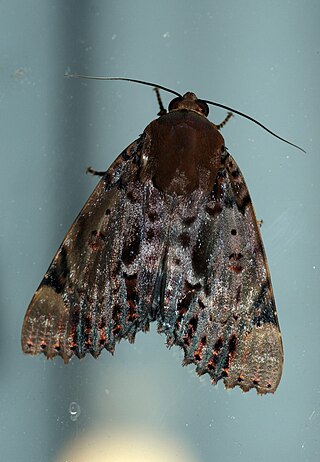
Arcte coerula, the ramie moth, is a moth of the family Noctuidae. The species was first described by Achille Guenée in 1852. It is found from in south-east Asia, including Fiji, India, Sri Lanka, Myanmar, Japan, New Guinea, Taiwan and Norfolk Island. It has been recently observed in Hawaii, on the island of Maui.
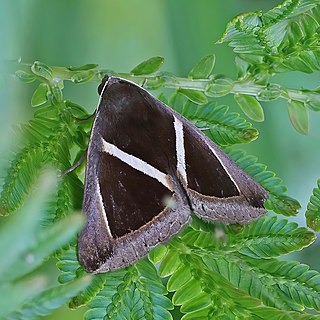
Chalciope mygdon, the triangular-striped moth, is a moth of the family Noctuidae. The species was first described by Pieter Cramer in 1777. It is found from the Oriental region to Sundaland.

Leucania loreyi, the cosmopolitan, false army worm or nightfeeding rice armyworm, is a moth of the family Noctuidae. It is found in most of African countries, the Indo-Australian subtropics and tropics of India, Sri Lanka, Myanmar, the eastern Palearctic realm, and the Near East and Middle East. The species was first described by Philogène Auguste Joseph Duponchel in 1827.

Chadisra bipars is a moth of the family Notodontidae. It was described by Francis Walker in 1862 and is found in the Indomalayan realm.

Serrodes campana is a species of moth of the family Erebidae first described by Achille Guenée in 1852. It is found from the Indo-Australian tropics to eastern Australia, Fiji, Samoa and New Caledonia. It is also present in Japan, Korea and Sri Lanka. The adult is a fruit piercer, but also feeds on flower nectar.
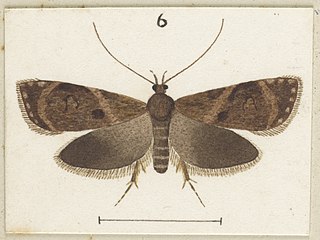
Izatha austera is a species of moth in the family Oecophoridae. It is endemic to New Zealand. The larvae of this species feed on dead wood by tunnelling into branches of its host species. The larvae matures from September and is on the wing in the months of December to January. The adult moth is variable in colouration but is seldom observed.
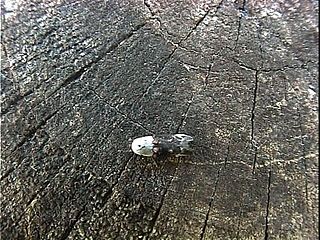
Trachypepla euryleucota is a species of moth in the family Oecophoridae. It is endemic to New Zealand and can be found throughout the country. They inhabit native forest and the larvae are leaf litter feeders and have also been found feeding on and in bird nests. Adults are on the wing from December to March, are nocturnal and are attracted to light. During the daylight hours they can be sometimes be observed resting on walls or fences. It has been hypothesised that the adults resemble an opening manuka flower bud or bird droppings in order to camouflage themselves from predators. The raised tufts on their forewings possibly also assist with camouflaging this moth when they rest on lichen.

Heterocrossa gonosemana is a species of moth in the family Carposinidae. It is endemic to New Zealand.

Ischyja manlia is a species of moth of the family Noctuidae first described by Pieter Cramer in 1776. It is found in the Indian subregion, Sri Lanka, Myanmar, Thailand, China, Okinawa, Sundaland, Sulawesi, Korea, the southern Moluccas, Australia (Queensland) and Palau. Adults pierce the skin of fruit to suck the juice.

Oraesia emarginata is a species of moth of the family Erebidae first described by Johan Christian Fabricius in 1794. It is found in Australia, New Caledonia, Indonesia, New Guinea, Pakistan, the Philippines, India, Sri Lanka, Sulawesi, Taiwan, China, Japan, Korea and Nepal as well as Eritrea, Ethiopia, Kenya, Namibia, Nigeria, South Africa, Tanzania, the Gambia, Uganda, Oman and Yemen.
Metacrateria pulverulella is a species of snout moth. It was described by George Hampson in 1918. It is found in Sri Lanka.

Trachypepla semilauta is a moth of the family Oecophoridae and was first described by Alfred Philpott in 1918. It is endemic to New Zealand and has been collected in Southland. This species inhabits southern beech forest on the side of mountains. Adults are on the wing in January.

Sphingomorpha chlorea, the sundowner moth, is a species of moth in the family Erebidae that is native to Africa and southern Asia. The species was first described by Pieter Cramer in 1777. It is a fruit-piercing moth and a notorious pest in orchards. The fruit is pierced while performing a vertical and rhythmic movement of the head.

Tingena penthalea is a species of moth in the family Oecophoridae. It is endemic to New Zealand and has been observed in Wellington and the Tararua Range. The adults of this species are on the wing from December until February.
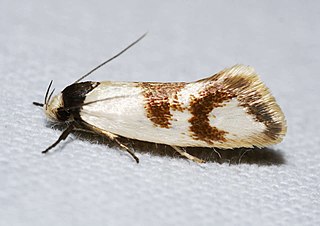
Antipterna trilicella is a species of moth in the family Oecophoridae, first described by Edward Meyrick in 1885 as Ocystola trilicella. It appears to be a moth endemic to Australia and confined to the east coast, occurring in Victoria, New South Wales and Queensland.

Trachypepla lichenodes is a moth of the family Oecophoridae first described by Edward Meyrick in 1883. It is endemic to New Zealand and has been found in both the North and South Islands. It inhabits native forest and adults of this species are on the wing from November to January. The adult moths are similarly coloured to native lichen species however this colouration is variable in the extent and depth on the forewings.

Chrysorthenches virgata is a species of moth in the family Plutellidae. It was first described by Alfred Philpott in 1920. It is endemic to New Zealand and has been found in the North, South and Chatham Islands at altitudes ranging from sea-level up to approximately 1000 m. This species inhabits areas where its larval host plants, Libocedrus bidwillii and Cupressus macrocarpa are common. The larvae feed on the leaves of their hosts from under a silk shelter and pupate in a cocoon of thick silk covered in frass. Adult moths are on the wing from September to February as well as in April and June.



















